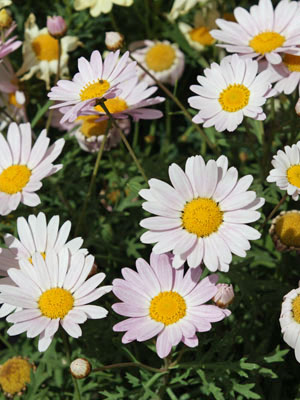Crop Rotation Group
Miscellaneous
|

|
Soil
Fertile, well-drained soil enriched with compost, with a neutral to slightly acidic pH.
|
Position
Full sun.
|
Frost tolerant
No, marguerite daisies are perennial evergreen shrubs in tropical climates, but are best grown as annuals in temperate climates.
|
Feeding
Drench with a liquid organic fertilizer monthly throughout the summer.
|
Companions
-
|
Spacing
Single Plants: 11" (30cm) each way (minimum)
Rows: 11" (30cm) with 11" (30cm) row gap (minimum)
|
Sow and Plant
Marguerite daisies can be started from seed, but strong-blooming hybrid cultivars are propagated vegetatively and must be purchased as plants. Set out plants in mid spring after the soil begins to warm. Young plants need water when they are actively growing. A surface mulch suppresses weeds and retains soil moisture while making the plants look more attractive.
Our Garden Planning Tool can produce a personalized calendar of when to sow, plant and harvest for your area.
|
Notes
Improved varieties of marguerite daisy can bloom for three months or more in hospitable climates. The plants prefer cool nights and may not perform well in hot climates. Where summers are moderate, marguerite daisy is an unstoppable bloomer, with each plant producing hundreds of daisies in white, yellow, or soft pastel pink. In autumn, plants can be brought into a cool basement or garage where temperatures stay above 50°F (10°C) and allowed to become semi-dormant. Provided with only enough water to keep them alive, the plants should perk up in spring and offer stem cuttings that can be rooted and grown into new plants.
|
Harvesting
Gather marguerite daises to use as cut flowers when they are newly opened. Trim the stem ends every other day and reset in fresh water to prolong vase life. Cutting off old flower stems encourages reblooming and keeps the plants looking neat.
|
Troubleshooting
Marguerite daisies have few pest problems, thought they cannot tolerate humid heat, particularly warm, humid nights.
|